Related Research Articles

Infrared astronomy is astronomical observation of astronomical objects using infrared (IR) radiation. The wavelength of infrared light ranges from 0.75 to 300 micrometers. Infrared falls in between visible radiation, which ranges from 380 to 750 nanometers, and submillimeter waves.

The Infrared Astronomical Satellite (IRAS) was the first-ever space telescope to perform a survey of the entire night sky at infrared wavelengths.
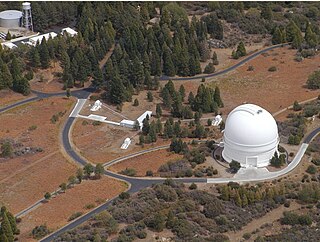
Palomar Observatory is an astronomical research observatory in San Diego County, California, United States, in the Palomar Mountain Range. It is owned and operated by the California Institute of Technology (Caltech). Research time at the observatory is granted to Caltech and its research partners, which include the Jet Propulsion Laboratory (JPL), Yale University, and the National Optical Observatories of China.
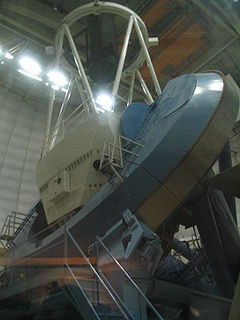
Observational astronomy is a division of astronomy that is concerned with recording data about the observable universe, in contrast with theoretical astronomy, which is mainly concerned with calculating the measurable implications of physical models. It is the practice and study of observing celestial objects with the use of telescopes and other astronomical instruments.

The Apache Point Observatory is an astronomical observatory located in the Sacramento Mountains in Sunspot, New Mexico, United States, approximately 18 miles (29 km) south of Cloudcroft. The observatory is operated by New Mexico State University (NMSU) and owned by the Astrophysical Research Consortium (ARC). Access to the telescopes and buildings is private and restricted.
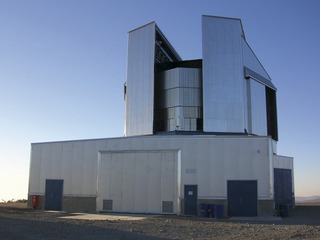
The VISTA is a wide-field reflecting telescope with a 4.1 metre mirror, located at the Paranal Observatory in Chile. It is operated by the European Southern Observatory and started science operations in December 2009. VISTA was conceived and developed by a consortium of universities in the United Kingdom led by Queen Mary University of London and became an in-kind contribution to ESO as part of the UK's accession agreement, with the subscription paid by the UK Science and Technology Facilities Council (STFC).

The NASA Infrared Telescope Facility is a 3-meter (9.8 ft) telescope optimized for use in infrared astronomy and located at the Mauna Kea Observatory in Hawaii. It was first built to support the Voyager missions and is now the US national facility for infrared astronomy, providing continued support to planetary, solar neighborhood, and deep space applications. The IRTF is operated by the University of Hawaii under a cooperative agreement with NASA. According to the IRTF's time allocation rules, at least 50% of the observing time is devoted to planetary science.

An astronomical survey is a general map or image of a region of the sky that lacks a specific observational target. Alternatively, an astronomical survey may comprise a set of many images or spectra of objects that share a common type or feature. Surveys are often restricted to one band of the electromagnetic spectrum due to instrumental limitations, although multiwavelength surveys can be made by using multiple detectors, each sensitive to a different bandwidth.
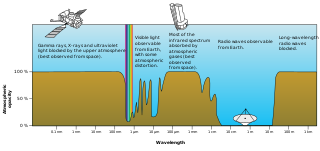
Visible-light astronomy encompasses a wide variety of observations via telescopes that are sensitive in the range of visible light. Visible-light astronomy is part of optical astronomy, and differs from astronomies based on invisible types of light in the electromagnetic radiation spectrum, such as radio waves, infrared waves, ultraviolet waves, X-ray waves and gamma-ray waves. Visible light ranges from 380 to 750 nanometers in wavelength.
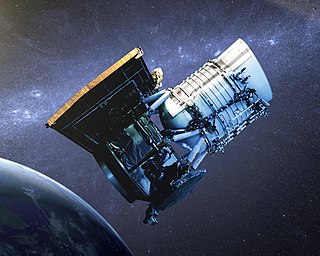
The Wide-field Infrared Survey Explorer is a NASA infrared-wavelength astronomical space telescope launched in December 2009, and placed in hibernation mode in February 2011. It was re-activated in 2013 and renamed the Near-Earth Object Wide-field Infrared Survey Explorer (NEOWISE). WISE discovered thousands of minor planets and numerous star clusters. Its observations also supported the discovery of the first Y Dwarf and Earth trojan asteroid.

A telescope is an optical instrument using lenses, curved mirrors, or a combination of both to observe distant objects, or various devices used to observe distant objects by their emission, absorption, or reflection of electromagnetic radiation. The first known practical telescopes were refracting telescopes invented in the Netherlands at the beginning of the 17th century, by using glass lenses. They were used for both terrestrial applications and astronomy.

An infrared telescope is a telescope that uses infrared light to detect celestial bodies. Infrared light is one of several types of radiation present in the electromagnetic spectrum.

The Wide Field Camera 3 (WFC3) is the Hubble Space Telescope's last and most technologically advanced instrument to take images in the visible spectrum. It was installed as a replacement for the Wide Field and Planetary Camera 2 during the first spacewalk of Space Shuttle mission STS-125 on May 14, 2009.
This is a list of infrared topics.
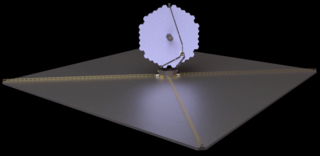
The Large Ultraviolet Optical Infrared Surveyor, commonly known as LUVOIR, is a multi-wavelength space telescope concept being developed by NASA under the leadership of a Science and Technology Definition Team. It is one of four large astrophysics space mission concepts being studied in preparation for the National Academy of Sciences 2020 Astronomy and Astrophysics Decadal Survey. While LUVOIR is a concept for a general-purpose observatory, it has the key science goal of characterizing a wide range of exoplanets, including those that might be habitable. An additional goal is to enable a broad range of astrophysics, from the reionization epoch, through galaxy formation and evolution, to star and planet formation. Powerful imaging and spectroscopy observations of Solar System bodies would also be possible. LUVOIR would be a Large Strategic Science Mission and will be considered for a development start sometime after 2020. The LUVOIR Study Team has produced designs for two variants of LUVOIR: one with a 15.1 m diameter telescope mirror (LUVOIR-A) and one with an 8 m diameter mirror (LUVOIR-B). LUVOIR can observe ultraviolet, visible, and near-infrared wavelengths of light. The Final Report on the 5-year LUVOIR mission concept study was publicly released on 26 August 2019.

NIRCam is an instrument aboard the to-be-launched James Webb Space Telescope. It has two major tasks, as an imager from 0.6 to 5 micron wavelength, and as a wavefront sensor to keep the 18-section mirrors functioning as one. In other words, it is a camera and is also used to provide information to align the 18 segments of the primary mirror. It is an infrared camera with ten mercury-cadmium-telluride (HgCdTe) detector arrays, and each array has an array of 2048x2048 pixels. The camera has a field of view of 2.2x2.2 arc minutes with an angular resolution of 0.07 arcsec at 2 microns. NIRCam is also equipped with coronagraphs, which helps to collect data on exoplanets near stars. It helps with imaging anything next to a much brighter object, because the coronagraph blocks that light. NIRCam is housed in the Integrated Science Instrument Module, to which it is attached physically by struts. It is designed to operate at 37 Kelvin, so it can detect infrared radiation at this wavelength. It is connected to the ISIM by struts and thermal straps connect to heat radiators, which helps maintain its temperature. The Focal Plane Electronics operated at 290 kelvin.

Origins Space Telescope (Origins) is a concept study for a Far-Infrared Surveyor space telescope mission. A preliminary concept in pre-formulation, it was presented to the United States Decadal Survey in 2019 for a possible selection to NASA's large strategic science missions. Origins would provide an array of new tools for studying star formation and the energetics and physical state of the interstellar medium within the Milky Way using infrared radiation and new spectroscopic capabilities.

Asteroid impact prediction is the prediction of the dates and times of asteroids impacting Earth, along with the locations and severities of the impacts.